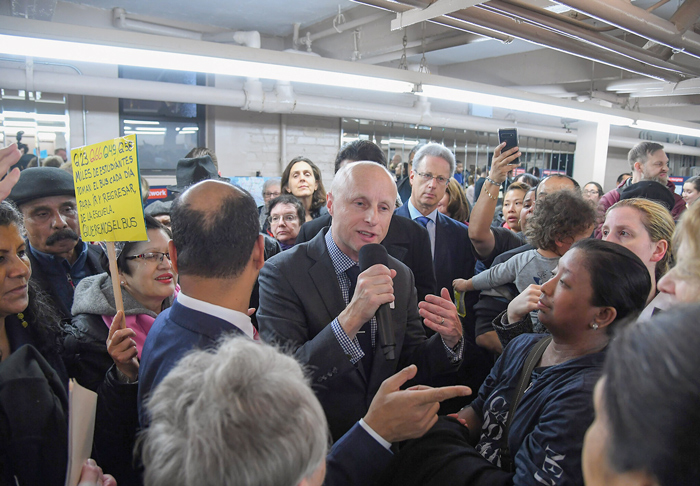By Forum Staff
The Queens Bus Network Redesign Plan has seemingly been panned by World’s Borough residents.
“We all hoped when this bus redesign plan was announced it would be a much more efficient way for our buses to navigate the city. We imagined the bus would no longer stop every two blocks, it would come much more often, be more reliable and go to new places. We imagined camera enforced bus lanes, all-door boarding and New York City Transit working with DOT to eliminate choke points,” guest columnist Jim Burke wrote on Streetsblog NYC. “The Bus Redesign team demonstrates an inferiority complex about buses. They think no one wants to take buses, and if they do only, they take them only as a last resort or the means to get to the subway.”
So why has the Metropolitan Transportation Authority decided to redesign the massive Queens system? According to MTA New York City Transit officials, the borough’s bus network “has not substantially changed to meet the evolving needs of customers. We’ve made minor changes to pieces of the network, but have not kept pace with growth in Queens. Our customers asked us to take a fresh look at how we can redesign the Queens Bus Network to provide more reliable service, shorter travel times, and better connections. Nearly 52 percent of Queens residents rely on public transit for their daily commutes, and at least 11 percent commute primarily by bus. So, it is imperative that we reinvent the borough’s bus network to better serve its residents and workers, so they can spend less time and energy commuting.” The Draft Plan is our proposal to address the following:
Service Reliability: Customers apparently told the MTA that Queens buses are unreliable and slow, often because they are stuck in traffic. The On-Time Performance for Queens bus routes decreased 12 percent from 2014 to 2018. Queens has a Customer Journey Time Performance (of 70 percent. CJTP measures the percentage of trips successfully made no more than five minutes later than scheduled. Increased congestion, especially in areas like downtown Flushing and Jamaica, negatively impacts the speed and reliability of service. While only one part of a route may experience congestion, the delays, bus bunching, and gaps in service caused by that congestion ripple throughout the entire route, affecting reliability for the majority of bus customers regardless of where they use the service.
Bus Speeds: Average bus speeds in Queens are the second highest of the five boroughs at 8.7 miles per hours. However, that number is down 3.3 percent from 2015, when the average bus speed was 9.0 MPH. • Slower bus speeds reduce route reliability and decrease productivity, further deterring people from choosing to ride the bus. Ridership Decline • Bus ridership in Queens fell 5.4 percent from 2014 to 2019, from 728,872 to 689,702 average weekday riders. • The decline in ridership can be attributed to several factors, including slower bus speeds and decreased reliability, leading to modal shifts to other kinds of transportation, such as the subway and Transportation Network Companies (TNCs). Central Business District Tolling • The implementation of Central Business District Tolling (CBDT), where vehicles are charged as they enter Manhattan south of 60th Street, will be an effective way to reduce congestion within the City and further encourage Queens residents and employees to seek out alternative means of transportation other than the car. • CBDT will also provide the MTA with a new capital revenue source that may help to address budgetary issues. The Draft Plan that follows is a first look at how we can improve bus service in Queens to benefit the greatest number of customers. The plan addresses comments received during public open houses, from on-street interviews, and from our online survey. It recognizes the clear need to completely redesign the Queens Bus Network, working within the known structural and resource constraints. By sharing this Draft Plan, we hope to inspire discussion, initiate conversations about our proposal, and listen to other ideas to be taken into consideration.
Wait times, slow buses, indirect routes, and bus lanes blocked by illegally parked or standing vehicles are the biggest challenges to providing efficient, reliable service in Queens, and make the biggest impact on our customers’ commutes. To improve travel times and enhance connections across the borough, we plan to: • Streamline bus routes, making them more simple and direct • Design a network with easy connections and frequent all-day bus service • Improve route connections so that not all routes funnel into two or three areas of Queens Connectivity • While population and employment densities in Queens are concentrated largely along subway lines, many residences, community facilities, employment centers, academic institutions, and other key destinations are only accessible by bus (particularly in eastern Queens). • Customers told us that they rely on multiple bus routes, subway lines, or commuter rail for their commutes. Improving connectivity at transfer locations is necessary to ensure customers have a quick and easy transition between buses and with other kinds of public transit. Bus Stop Balancing • Currently, the average distance between bus stops in New York City is 805 feet. In Queens, the average is slightly higher at 850 feet. Both are much shorter than the standard in international peer transit systems, which typically range from 1,000 to 1,680 feet. • When a bus stops more frequently along a route, exiting, stopping, and re-entering the flow of traffic, it loses speed and increases customers’ travel time. During off-peak hours, it typically takes a bus about 20 seconds to re-enter traffic. During rush hour, that can jump up to over a minute. By removing closely-spaced and under-utilized stops throughout Queens, we can keep buses moving with the flow of traffic and get customers where they need to go more quickly.
Photos Courtesy of Marc Hermann/
MTA New York City Transit

